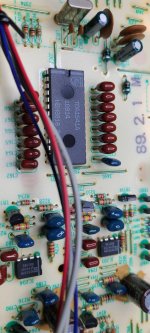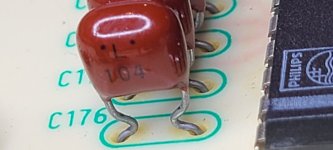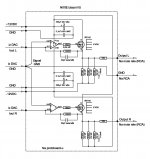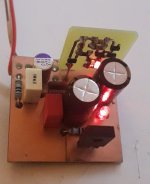This was information that I also tried to decipher for a long time. Use a type of capacitor that is suitable for audio, because the sound quality can depend on it 😊Miro, can i ask why you choice 4.7 and 47uf electrolitics for C15,C25,C16 and C26? And not 1uf (or2.2) and 10uf(or22) tants?
Can there be experimented with these?
C16 is definitely noise reduction capacitor for voltage reference. You can use from 10uF up to 100uF and you won't spoil anything (the datasheet shows that it is the RC filter).
Questionable is C15, because it reduces the output noise from the control portion of the DAC. I would probably put a higher value than 1uF here, but not more than 10uF (because we don't know how this filtration works).
Probably no one has figured out what is better 🤣 ... just don't give less than 1u+10u.
Miro, did you play around with DEM reclocking when putting together your 1541 circuit? I’m hoping to experiment soon, but curious if you compared reclock to the built-in DEM oscillator.
@codyt I did not play with DEM, no comparizon yet. I assume you can hear a difference when software player sends low audio data (player volume is down).
When I tried music on low volume, I don't hear or recognize distortion. 😊
There is a nice article referencing to ECDesign's thread.
When I tried music on low volume, I don't hear or recognize distortion. 😊
There is a nice article referencing to ECDesign's thread.
Attachments
Both capacitors C16 and C15 should necessarily be with as little leakage current as possible and preferably for audio use, because that way they will have the least influence on the reference voltage and bias. Capacitors with high leakage current like OS-CON or similar low esr and low imp. will degrade the sound so they should be avoided in that position.This was information that I also tried to decipher for a long time. Use a type of capacitor that is suitable for audio, because the sound quality can depend on it 😊
C16 is definitely noise reduction capacitor for voltage reference. You can use from 10uF up to 100uF and you won't spoil anything (the datasheet shows that it is the RC filter).
Questionable is C15, because it reduces the output noise from the control portion of the DAC. I would probably put a higher value than 1uF here, but not more than 10uF (because we don't know how this filtration works).
Probably no one has figured out what is better 🤣 ... just don't give less than 1u+10u.
How to test capacitor leakage current?
For this position on the PCM1702, I prefer UKZ because it is the best I have tested, although there are others but not equally good, for example Rubycon ZLJ 100uF/35V or the popular FC. The voltage of the capacitor is also important, the higher it is, the lower the leakage current will be.
@grunf Thanks for the helpful clarification. This original BOM contains quite good capacitors for that use, what do you think? 🙂 AD1862 BOM v1.3
Speaking of capacitors, I have a new victim on the bench. This Nakamichi CDC-3a will give up its TDA1541a and the Signetics 5532s for sure. Are the red poly decoupling caps or blue timing caps worth using in a DAC?
Yes, they are a good choice 🙂@grunf Thanks for the helpful clarification. This original BOM contains quite good capacitors for that use, what do you think? 🙂 AD1862 BOM v1.3
It's not a problem to make a test, so maybe someone will find some more good elkos.
Very good and helpful info, thanks for posting this Miro.....There is a nice article referencing to ECDesign's thread.
I can see cap 'rolling' coming soon.... 🤣
Do you have a picture?Speaking of capacitors, I have a new victim on the bench. This Nakamichi CDC-3a will give up its TDA1541a and the Signetics 5532s for sure. Are the red poly decoupling caps or blue timing caps worth using in a DAC?
Doh!Do you have a picture?
Attachments
hello @grunf , i have a spare miro1862 board which i have installed c15 with tantalums. I have not tested the board yet. Do you think i should change out the tantalums?Yes, they are a good choice 🙂
It's not a problem to make a test, so maybe someone will find some more good elkos.
If leakage current is a concern depending on the tantalum type they may have even lower leakage current than UKZ. And typically tantalums (or tantalum polymers) have much lower leakage current than specified in datasheet. I use SMD tantalums which have much lower inductance than leaded electrolytics.hello @grunf , i have a spare miro1862 board which i have installed c15 with tantalums. I have not tested the board yet. Do you think i should change out the tantalums?
Miro, another one pcm63p-k done 🙂 Hats down to you, this is a beast! Now just to 3d model a proper case, and off to cnc milling 😊

Nice setup Brijac! I like the cut psu board, Hehe!
What I/V output stage are you using with PCM63P-K?
What I/V output stage are you using with PCM63P-K?
Thanks 🙂 I was thinking of designing just that half and printing the pcb, but then i said f it, and cut the one in half 😅 Consulted Miro, got green light, works flawlesly.Nice setup Brijac! I like the cut psu board, Hehe!
What I/V output stage are you using with PCM63P-K?
They are newclassd ultimate edition mk2 opamps. And i/v resistors are z-foil.
I agree that there are smd tantalums with low leakage current, not all types, mostly high temperature automotive and industrial types, but they have their disadvantages compared to standard (audio )electrolytes.If leakage current is a concern depending on the tantalum type they may have even lower leakage current than UKZ. And typically tantalums (or tantalum polymers) have much lower leakage current than specified in datasheet. I use SMD tantalums which have much lower inductance than leaded electrolytics.
I don't know if you tested them for leaks, but I did last summer at the suggestion of Walt Jung, and I was really surprised by the results. Some of the types we like to use are truly disastrous, such as polymers of any type.
This leakage does not bother with decoupling, on the contrary, I use OS-CON and similar types, but with references, some regulators, tubes and more sensitive analog circuits, I avoid them in a wide arc.
If you have a Walt Jung superregulator I suggest you do a test with the cap in the reference filter, I was of the same opinion as you but Walt quickly dissuaded me after doing a couple of tests in my audio system.
For example, in my new 5V regulator (Walt Jung UnivReg_122714), OS-CON is still decoupling because it is a regulator for a digital filter, but at the input of the op amp. are two UKZs operating at 1/25 of the nominal voltage so the leakage current is well below 0.1uA.
And believe me, you can hear it in a audio system🙂
Attachments
- Home
- Source & Line
- Digital Line Level
- DAC AD1862: Almost THT, I2S input, NOS, R-2R




